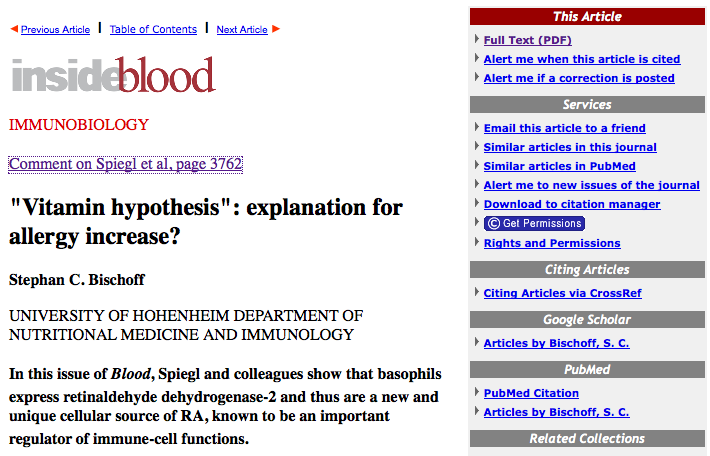I already suspect that science has more to do with believes than religion. However, only very recently I came across this paper (when working on eosinophils) that stretches this view to its limits: “Eosinophil cells, pray tell us what you do!” Or is that a new incarnation of Spinoza’s God in Nature?
Category Archives: Allergy
TCR-HLA-B*4405(EENLLDFVRF)
There are not two cells in the human body that have an identical DNA sequence as detailed here earlier. But not only ageing, already basic B and T cell recombination introduces variation. And there might be more: HLA micropolymorphism! Continue reading TCR-HLA-B*4405(EENLLDFVRF)
Vitamin D as workplace sensitizer
A recent ERJ correspondence letter highlights vitamin D (among other others) as sensitizer at the workplace.
Skin sensitisers are typically more hydrophobic than respiratory sensitisers. Both water-soluble and fat-soluble vitamins are used as additives in the food industry. Exposure at work to both of the above classes of vitamin compounds may occur, resulting in respiratory and skin sensitisation of workers during the manufacturing process.
Another challenge of the hygiene hypothesis
The hygiene hypothesis usually assumes an “underemployed” system that is directed against self-defined allergen targets – a rather mechanistic view of a half filled barrel. A new Nature paper on memory CD8 T-cells now explains why this view is rather odd Continue reading Another challenge of the hygiene hypothesis
How to transfer a MS SQL server to an OS X sqlite database
Here is what worked for me: Start up MS SQL server and run a tool that can be compiled from sources at Codeproject. Transfer the resulting SQLITE3 database to the Mac where it can be accessed by R via the RSQLite library. Many thanks to Liron Levi and his patient help with tables having more than 1000 columns!
I am in the process of setting up a graphical ER management tool while the native ODBC driver still seem to have some problems. Any workaround is greatly appreciated.
Another rediscovery of the vitamin hypothesis
Blood has now also an account on the vitamin hypothesis.

Following some earlier descriptions in Reed 1932, Selye 1962, Wjst 1999 and Wieringa 2008, the discovery frequency seems to increase – a good sign for some progress. Bischoff writes about vitamin A where we have only some limited evidence.
Porque no te callas?
Here is the abstract of another pro D3 article by Gilchrest in the AJCN with a few comments by me (notJuan Carlos) Continue reading Porque no te callas?
Asthma: a iatrogenic disease cont’d
I had already a thread here about asthma and iatrogenic factors last month including estrogens, vaccines, antibiotics, vitamin D, paracetamol, and Caesarean section. There may be even another kid on the block: folate. At least in mice in utero supplementation with methyl donors enhances allergic airway disease Continue reading Asthma: a iatrogenic disease cont’d
Münchhausen Trilemma
A scintillatingly witty reply to one of my recent letters say that Continue reading Münchhausen Trilemma
Endotyping asthma
“Endotyping asthma” is a thoughtful review of the complex risk factors and mechanisms involved in asthma pathogenesis. It marks a new direction – away from Th2 immunity towards a bunch of novel disease pathways. The author also touches briefly asthma candidate genes, grouping them into 7 areas Continue reading Endotyping asthma
How to restore a Windows XP system in 30 minutes
Some hard disk crashes took me longer than that but here is my 3 step method:
- The Slipstreamer will create a boot CD from an existing Windows installation.
- Update it with Service Pack 3 or look for xpsp3_5512.080413-2113_usa_x86fre_spcd.iso
- Restore any more volumes with Drivesnapshot from any image on an USB drive.
Hopefully you are not reading this too late…
Asthma is a iatrogenic disease
The new Lancet has a paper from our own group as well as another one from ISAAC. We have already suggested earlier that asthma is a iatrogenic disease- the ISAAC paper now confirms at least the long suspected association with paracetamol use – gratulations to my London friend who had been working so long on this hypothesis. The accompanying editorial puts in into context:
Furthermore, although many important potential confounders were included in multivariate analyses, confounding by underlying respiratory disease, differences in hygiene, and use of other antipyretics might also explain the findings.
To put it more on a general level – more iatrogenic factors cannot be excluded, yea, yea.
Try to stay away from rants and comparisons
for living then longer … This might be a good rule for private life (and even for a scientific career) but not so much for the progress of science.
There is another allergy gene paper on FCER1A and RAD50. FCER1A has some tragedy as the authors believed for many years in FCER1B (and others in FCER2).
Another tragedy comes with the second gene – Continue reading Try to stay away from rants and comparisons
ORMDL3 – more inconsistencies in the Nature paper
It seems that CEA just published my rather critical view of the recent ORMDL3 association paper. My letter had been first submitted to “Nature” but rejected after review.
A rebuttal seemed to be necessary as the authors repeatedly highlight ORMDL3 as a new asthma gene – in the printed Nature paper, in the Nature podcast and in the accompanying press releases. They even continue with reviews saying that
Completion of the human genome sequence and the advent of genome-wide association studies have resulted in the identification of two novel asthma susceptibility genes, ORMDL3 and CHI3L1, in the past year.
Continue reading ORMDL3 – more inconsistencies in the Nature paper
SNP batch annotation of GWAs
Genowatch (paper|website) is doing pretty well by annotating large SNP sets that would require otherwise numerous hours to map their position on genes, biological function and pathways. Continue reading SNP batch annotation of GWAs